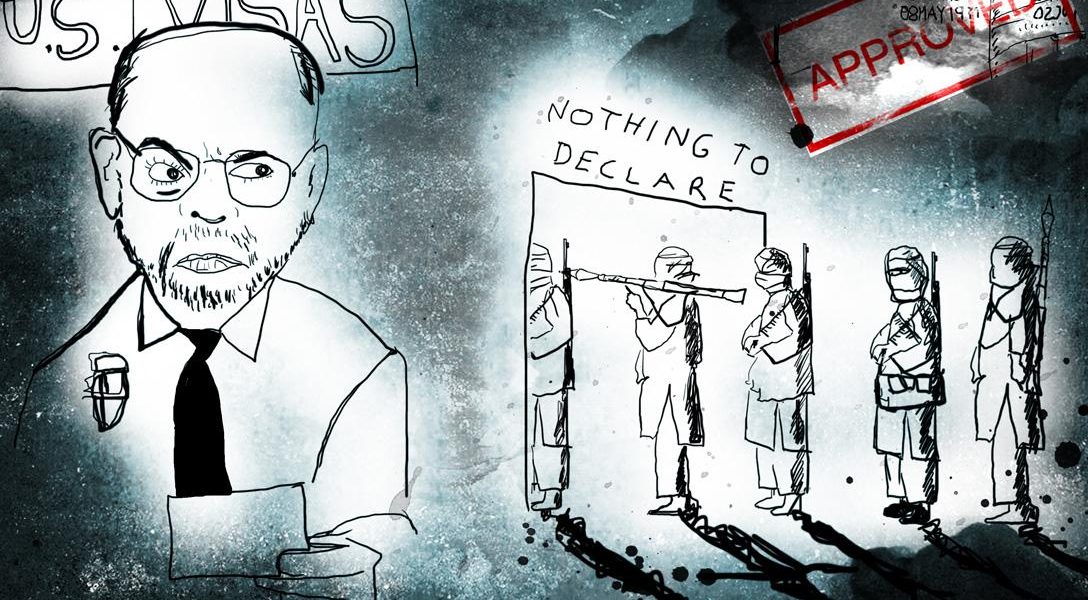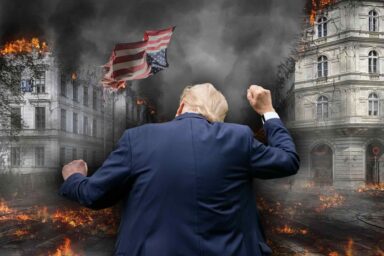In this remarkable first-hand account, a former US consular official describes a pipeline created by the CIA that enabled terrorists to slip into the US with ease. Among them were the mujahideen of Afghanistan — who later became al-Qaeda. Authentic and mind-blowing.
Introduction:
Michael Springmann was, to all appearances, your run-of-the-mill junior level consular employee, but he was not in a usual place, nor in a usual time. His government sent him to Saudi Arabia right as it was preparing for a battle royale with the USSR in Afghanistan. In this excerpt from his book, Springmann describes a consulate teeming with CIA personnel, and reveals how, as head of the American visa bureau, he was ordered not to follow his best instincts but instead to approve visas for all manner of dubious individuals. In retrospect, he realized he was witnessing the mujahideen pipeline — the flow of young fighters to take on the Soviets — the same people who later became al-Qaeda.
Springmann, it turns out, was not run-of-the-mill at all. He did not behave as expected. He asked too many questions and made too many complaints to too many agencies about what was going on. For sounding the alarm, the State Department fired him. The story, in his words:
“This tale is a sordid sketch of backstabbing, disloyalty, double crosses, faithlessness, falsity, perfidy, sellouts, treachery, and betrayal. All of this is in addition to the stupidity and incompetence normally manifested by the State Department and the intelligence services.”
Here, in anticipation of the 14th anniversary of the 9/11 tragedy, is the first of a three-part series of excerpts from Visas for Al-Qaeda: CIA Handouts that Rocked the World by J. Michael Springmann (Daena Publications, Washington, DC LLC 2014). These excerpts have been edited and compressed.
Enter the Pawn
Having just joined the “real” Foreign Service, I was assigned to Jeddah. There, I learned the Kingdom of Saudi Arabia was a mysterious and exotic place — but nowhere near as exotic and mysterious as the American consulate general on Palestine Road.
Upon arrival, I found, as a new visa officer, I was expected to winnow more than one hundred applications a day, separating them into “issuances,” “refusals,” and what turned out to be “free passes for CIA agents.”
However, none of the clean-cut young fellows at the consulate, or even the pudgy, “been around too many blocks” types, bothered to clue me in on this special class of applicants.
One day, Eric Qualkenbush, the CIA Base Chief, stopped me while I was walking on the consulate’s huge compound. He had a request. Could I issue a visa to one of his agents, an Iranian whose family owned an Oriental rug store? Eric said, “Mike, make it look good (wink, wink). We want him in Washington for consultations.”
Flabbergasted, I said, “Sure.” Up to that point, I had had almost a daily battle with Jay Freres, the Consul General, along with other CIA officials, who demanded visas for peculiar people, that is, people whom law and regulation required me to refuse.
I also had running fights with visa applicants who told me to approve their paperwork or they would complain to Freres and have him overrule me.
Why, I wondered, did Qualkenbush explain what was coming? And why didn’t he tip me the wink about the others, instead of leaving me to fight continued violations of rule and directive all by myself?
If they followed law and regulation, and resisted illegal pressure to overlook the people who had no real reason for traveling to the United States, they “weren’t with the program” and could easily be dismissed as “incompetent.”
I was even more flummoxed when Eric’s agent appeared in line before me while I was on my stool behind the visa section’s armored window. Secure in my industrial-strength cinderblock office, I went through the interview:
Memo on company letterhead explaining trip and customers to be visited? Check. Properly filled out visa application form DS-156? Check. Clean passport with no hidden notations of previous travel refusals? Check. Coherent, comprehensive, clear account of travel purpose? Check. Previous US visa stamps? Check. Appropriate responses to my questions about proposed journey? Check. I issued the visa and wished I had more applicants like him. And yet …
I had heard in Washington about all sorts of abnormal problems tied to visas in Jeddah. None of it made sense at the time, but the office atmosphere after my arrival was increasingly poisonous as I invoked the Immigration and Nationality Act, and the Foreign Affairs Manual in preventing scruffy types from apparently trying to emigrate to the United States.
Despite my questioning people in the office, I began to suspect that something wasn’t quite right. I knew it wasn’t right when the State Department later fired me without explanation and then stonewalled my efforts to learn why.
The following story is what I learned about what was really happening in Jeddah, how I got there, and the dreadful consequences of what I learned to be American policy.
The Watchdog That Did Not Bark
First, the Consular Section’s job was to secure visas for CIA agents, i.e., foreigners recruited by American case officers. The Department of State and the Central Intelligence Agency collaborated on sending ignorant pawns to Jeddah, a place that was handling about forty-five thousand visa applications annually. If they processed the paperwork like automatons and didn’t ask awkward questions about the applicants, they kept their jobs.
If they followed law and regulation, and resisted illegal pressure to overlook the people who had no real reason for traveling to the United States, they “weren’t with the program” and could easily be dismissed as “incompetent.”
They worked with the American intelligence services and the State Department to destabilize governments the United States opposed. While it’s no secret, most knowledgeable people still refuse to talk about this agenda.
Second, the Department of State already had a watchdog in place to prevent this type of problem: the Bureau of Diplomatic Security. From its website:
D[iplomatic]S[ecurity] works with the Bureau of Consular Affairs on cases involving allegations of corrupt American Embassy employees, fraudulent document vendors, and the use of visas by terrorists, and those smuggling and trafficking drugs and human beings.
Passport and visa crimes are federal offenses punishable by up to 10 years in prison and a fine of $250,000. The maximum prison sentence is increased to 15 years if the offense is connected to drug trafficking, and to 20 years if connected to terrorism.
So who was committing these violations, and what were they doing? And why wasn’t the watchdog watching? As I later learned to my dismay, the visa applicants were recruits for the war in Afghanistan against the Soviet Union’s armed forces.
Further, as time went by, the fighters, trained in the United States, went on to other battlefields: Yugoslavia, Iraq, Libya, and Syria.
They worked with the American intelligence services and the State Department to destabilize governments the United States opposed. While it’s no secret, most knowledgeable people still refuse to talk about this agenda.
What Was That All About?
In 1986, the introductory class for new Foreign Service officers consisted of weeks of sitting through dreadfully boring and generally useless lectures. At the graduation session, class members received their orders, along with a small flag of their country of assignment. Mine was the green flag of the Kingdom of Saudi Arabia. I was to be a consular officer in Jeddah on that country’s west coast.
I was astonished. When I made discreet inquiry of John Tkacik as to how I ended up there, he replied that he thought I had bid on the assignment since I appeared so happy at the ceremony. I later contacted one of our lecturers.
My interlocutor told me that the State Department wanted someone a little older than the average junior officer (I was forty-one) for the Jeddah position, and someone with my experience at the Commerce Department because Jeddah was a hub of mercantile activity. This rationale left me with more questions than answers.
In accordance with Foreign Service practice, I wrote to the American Ambassador, Walter Cutler, in Riyadh and told him of my delight in joining his official family. I sent a similar letter to Jay Philip Freres, the American Consul General in Jeddah at the time.
I then went on to Arabic language class and engaged in regional and consular studies at the Foreign Service Institute (FSI), the educational arm of the State Department in Washington. Surprisingly, I got a call one day from a desk officer — those in Washington who follow political, economic, and social affairs in a country — for Saudi Arabia.
Ambassador Cutler was in town, and he invited me to meet with him. I expected it to be a five-minute “Hello and good-bye” session. Instead, Cutler kept me for about forty-five minutes, telling me the problems Greta Holtz, my predecessor, had created for our embassy in Riyadh.
Visas were being denied to servants of rich Saudi women who, after all, couldn’t travel to the United States without their entourage of hairdressers, seamstresses, and other factotums.
I sat there and listened and wondered at this report. Clearly, Cutler was conveying some message, but for the life of me, I could not puzzle it out. Afterward, I spoke to the desk officer, who had been there with me during the talk, asking what that meeting was really all about. His response was that he didn’t know, saying that Cutler (who had previously been ambassador to Zaire and Tunisia) was “just a queer duck.”
Years later, Cutler, then head of Meridian House, a nonprofit that promotes international understanding, flatly refused to talk to me about Jeddah. Despite his silence, he knew full well what had been going on.
In a discussion about recruits for the Afghan war in Robert Dreyfuss’s Devil’s Game, How the US Helped Unleash Fundamentalist Islam, Cutler is quoted as saying, “Where I was, nobody was looking ahead at what would happen to those unemployed freedom fighters.”
Contrary to what Cutler told me and, as I learned later, many of Jeddah’s visa applicants were mujahideen recruits, alleged “freedom fighters — not servants of rich Saudi women.
I began asking around about Cutler’s odd remarks on visas in Jeddah. Heeding the advice of a consular officer that anything out of the ordinary should be questioned as a source of potential trouble, I contacted Ellen Goff in the Executive Office for the Bureau of Near Eastern Affairs (NEA/EX). She told me that, yes, she had heard stories about visa problems in Jeddah, but she had no details on the subject.
Still puzzled and confused, I went off to Jeddah in September 1987. I later learned that I had been assigned to a CIA post, another unpleasant surprise. Most of the American officers and staff did not work for the State Department, but instead for the Agency (the CIA, or “Langley” for the location of the CIA in Virginia), or the National Security Agency (NSA).
A Cover Story?
Welcomed with open arms by Jay Freres, the Consul General — identified by the German journalist Julius Mader as a CIA official — and Henry Ensher, the political officer, I was told I was an improvement over Greta Holtz, whom they alleged had had terrible problems at the consulate.
Years later, I began to realize that this was more a cover story than anything else — especially since my visa refusal rate was within five percentage points of hers.
According to one biography, Holtz had strong ties to the intelligence services, having previously worked at the Defense Intelligence Agency (DIA), and later receiving the Christopher Award from the CIA.
For someone who created such problems for our embassy in Riyadh, Greta Holtz has done extremely well for herself, moving steadily up the promotion ladder. President Barack Obama named her Ambassador to Oman in September 2012. Her new official biography strangely omits her DIA service, saying just that she worked in the NATO policy office at the Defense Department. When in Washington, DC, she lives in a $2.4 million house in nearby Potomac, Maryland.
Requests, Demands, Threats
Later on, during my service in Jeddah, I began getting referrals from Freres, Ensher, and others, such as Paul Arvid Tveit — a commercial officer listed in namebase.org (no longer available due to hackers) as a CIA official. Initially, I was approached diffidently with the caveat that, while according to law and regulation, I had the final decision, they really wanted visas for their contacts.
While no example springs to mind, the referrals, for the most part, were unremarkable. Later, after I had begun questioning the credentials of many applicants because they lacked ties to Saudi Arabia or their own country, the requests became demands. Then, they became threats.
Next: Visas for Al-Qaeda, Part 2: Treachery
RELATED STORIES
Homeland Security Still Dodging Questions on Terrorist “Hands Off” List
Connecting the Dots on … US Failure to Stop Saudi Hijackers
FBI: Knew About Saudi 9/11 Hijacker Ties — but Lied to Protect “National Security”
Related front page panorama photo credit: Entrance to U.S. Consulate General in Jeddah, Saudi Arabia
(US Department of State Archive), Mujahideen in Kunar, Afghanistan (Erwin Franzen / Wikimedia),
- Michael Springmann (courtesy of J. Michael Springmann)



